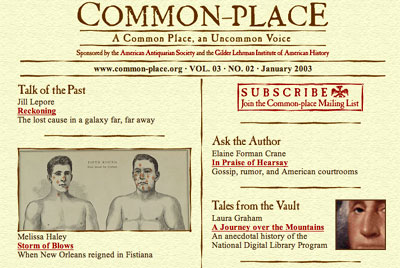talking history | syllabi | students | teachers | puzzle | about us
Common-Place
http://www.common-place.org
Sponsored by the American Antiquarian Society and the Gilder Lehrman Institute of American History.
Reviewed March 29, 2002.
There is nothing commonplace about this venture. Back when Internet start-ups were booming the stock exchanges, it was not uncommon to hear almost apocalyptic prophecies about an electronic revolution in the way scholars would exchange ideas. It has not happened—yet. In its Project Muse, Johns Hopkins University Press publishes over one hundred humanities journals online, but only two of them are really “online journals”; the rest are simply post-produced electronic versions of traditionally published quarterlies and annuals. From its start in 2000, however, Common-Place was conceived as, to cite its subtitle, an Interactive Journal of Early American Life, available only on the Web.
The coeditors, Jane Kamensky and Jill Lepore, and their production team have come up with a design calculated to make even antiquarians feel at home in this new medium. Navigational icons that resemble eighteenth-century woodcuts, colors that evoke long-faded paper and ink, a line length determined by the expectations that readers will bring to the site from their training as users of that other wonder of modern technology, the printed book—such features make the journal format easy to navigate, pleasing to the eye, and much more likely than the average Internet page (where flash often substitutes for substance, and the incitement seems to be always look and click on) to foster real reading and reflection.
The typical Common-Place article is also conventionally linear rather than interactive. For Kamensky and Lepore, “the web’s most important feature” is its power to bring “people together to discuss ideas.” They rightly see an Internet site as a place visitable by constituencies that existing modes of publication tend to segregate, so they pledge to be “a bit friendlier than a scholarly journal, a bit more scholarly than a popular magazine.” Contributors include chaired academics, museum curators, creative writers, and public school teachers. A prominent feature is an online message board that encourages comments on monographs, thereby allowing readers to become contributors and turning monographs into ongoing conversations. The archived postings from the first eighteen months suggest that the goal of reaching a broad-based audience is being achieved.
Six quarterly numbers of Common-Place have now been published. As I read through them, it struck me that the early editions made a more concerted effort to transform the message as well as the medium, to discuss early American history and culture in ways that would stretch beyond the academy’s various self-absorbed preoccupations. The January 2002 issue, however, also contains a wonderful lesson plan by Dean Eastman, who takes his high school history students into the cemetery to make history come alive, and an article by Gregory Fried on nineteenth-century photographic representations of African Americans that makes exemplary use of electronic technology’s capabilities as a visual medium. Given the Internet’s shaky reputation among so many scholars, it is understandable that Kamensky and Lepore want to move slowly from the familiar into whatever unknown futures the technology might make possible. By maintaining traditional standards while working to create new connections, they are doing a great service to anyone interested in the nation’s past and to everyone with a stake in those possible futures.
Stephen Railton
University of Virginia
Charlottesville, Virginia

